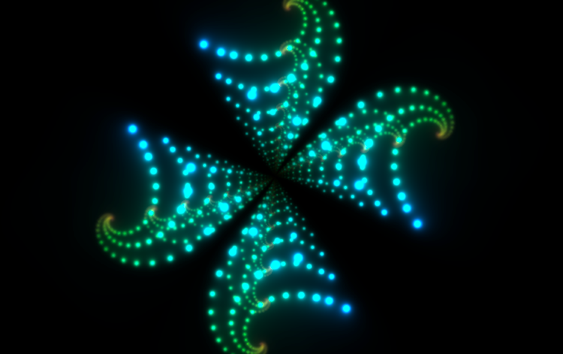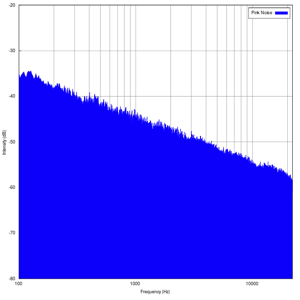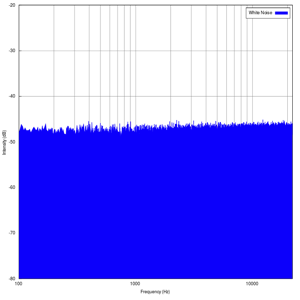
“Within You Without You,” The Beatles
1967
The Color of Sound
How would you describe a sound to someone without using descriptors that are unique to sound, like: loud, bassy, shrill, whining, atonal, or noisy?
Not a problem, because we most often describe a sonic experience with words related to our other senses: sharp, warm, angular, raspy, piercing, even, warbling, soft, smooth, or flat.
What about blue? I think of that as more of a style of music or mood instead of a type of sound. Why don't we use more colors to describe what we hear? Probably because a "yellow" sound could be cowardly. A "green" sound may be eco-friendly. A "purple" sound is probably regal. A "brown" sound - well, we'll leave that one alone.
What if we could see sound? Aside from graphical representations of sound like waveforms and meters, we can't just look at an orchestra and see sounds flying out of the trombones. I wish we could watch the beautiful tones flow from Itzhak Perlman's Stradivarius.
But we can - sort of. As reported by NPR, we can see certain sounds using a technique invented in the mid-19th century. Click on the link above to read about and watch a short video describing this process to get a clearer picture. To simplify, scientists watch the disturbance of heat waves by sound. Ever look down a highway on a hot summer day and see the heat creating wavy images? Scientists have used this phenomenon to "see" sneezes and aircraft wing turbulence. But Michael Hargather at New Mexico Tech uses it to study explosives.
So what's next? I would love be able to put on some goggles and see sounds and where they're coming from. Loud sounds would be bright. Bass would be blue, treble would be white, and green, red, and yellow would fill in the gaps. Imagine seeing green waves and ripples emanating from the violas, bubbles of blue from the tuba, and distinct columns of yellow and white from the violins. It would be like Peter Max was the conductor. With technology advancing at such a rapid rate, this may not be so far-fetched in our lifetimes. Color me crazy.
Did You Know?
- "White noise" in sound engineering describes randomly generating all the sounds in the frequency spectrum. SInce the sounds aren't generated at the same time, they are measured over a period of time. Each sound is at a consistent level.
- White noise sounds similar to a radio that is tuned to no station.
- White noise is often used in large offices to mask sounds from workers, computers, and other office machinery. People also use white noise generators to aid in sleeping.
- "Pink noise" is similar to white noise, but decreases in intensity each ascending octave.

- Pink noise is primarily used to measure the output of an audio device.
- Sound engineers play pink noise over monitor systems to check frequency response and level of speakers. If measurements show that a speaker produces some frequencies differently than the pink noise (more bass for example), then it is considered to have a "colored" response. Pro audio speaker manufacturers strive for a "flat" response from their products. This way an engineer isn't fooled into compensating for the difference while mixing.
- Live sound engineers use pink noise to reduce feedback and get maximum performance from speakers.
- Other types of noise used in analysis are violet, brown(ian), gray, blue. Other informal names for sound used in measurement are red, green, black, noisy black, and noisy white.
Tech Notes
Reducing feedback in a live sound situation is very tricky, especially if good sound performance is desired. The "squeal" you hear when a microphone is turned on is from a buildup of a certain frequency. It's usually the point at which the microphone and speaker are the most efficient. If one points a microphone at the same speaker that is amplifying it, then serious feedback occurs. Most speakers are placed in front of or beside performers so there is no direct bleed back into the microphone. If speakers are placed behind the performers (think The Who), then eliminating feedback is a bigger chore.
How do you eliminate feedback? Let's use the simplest set-up as an example: one microphone and one speaker. A graphic equalizer (GEQ), a device that increases or reduces frequency by octaves, is inserted after the microphone channel and just before the amplifier. The engineer slowly raises the amplifier level until the first inkling of feedback. Using the GEQ, the engineer locates the offending octave, ex: 630 Hz, by actually increasing that frequency creating more feedback. That octave is then reduced until feedback goes away.
Next, then amplifier is turned up a little more until the next inkling of feedback occurs, usually at another frequency, which is then reduced. These steps are repeated over and over until the amplifier is at a suitable level without feedback. Of course computer technology has simplified this process greatly with devices that rapidly reduce feedback "on-the-fly." And with software, engineers for permanent PA systems in large venues can even predict where feedback will occur before installation. They can then program in filtering or make changes to the architecture, equipment, or speaker placement.
Neil KestersonTags: Dynamix, Dynamix Productions, White noise, Pink noise, Brown noise, Feedback, Orchestra, Lexington, Kentucky, Recording, Clementine, Angels on Stage, Angels on Stage






